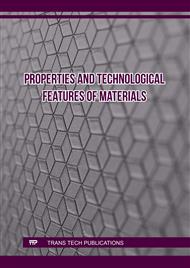[1]
A. Gourfi, L. Daoudi, Z. Shi, The assessment of soil erosion risk, sediment yield and their controlling factors on a large scale: Example of Morocco, Journal of African Earth Sciences. 147 (2018) 281-299.
DOI: 10.1016/j.jafrearsci.2018.06.028
Google Scholar
[2]
A. Benabdelkader, A. Taleb, J.L. Probst, N. Belaidi, A. Probst, Origin, distribution, and behaviour of rare earth elements in river bed sediments from a carbonate semi-arid basin (Tafna River, Algeria), Applied Geochemistry. 106 (2019) 96-111.
DOI: 10.1016/j.apgeochem.2019.05.005
Google Scholar
[3]
F. Kotti, L. Dezileau, G. Mahé, H.Habaieb, S. Benabdallah, M. Bentkaya, C. Dieulin, Impact of dams and climate on the evolution of the sediment loads to the sea by the Mejerda River (Golf of Tunis) using a paleo-hydrological approach, Journal of African Earth Sciences. 142 (2018) 226-233.
DOI: 10.1016/j.jafrearsci.2017.10.003
Google Scholar
[4]
A. Hadour, G. Mahé, M. Meddi, Climatic and anthropogenic impacts on the decrease of sediment discharge to the Mediterranean coast from the largest river of Maghreb, International Journal of Sediment Research. 36 (2021) 268-278.
DOI: 10.1016/j.ijsrc.2020.07.001
Google Scholar
[5]
L. Hammadi, A. Ponton, Rheological investigation of vase of dam: Effects of aging time, shear rate, and temperature, Applied Rheology. 27 (2017) 21-29.
Google Scholar
[6]
T. L.Zhao, S. S. Chen, C. J. Fu, Q. M. Zhong, Centrifugal model tests and numerical simulations for barrier dam break due to overtopping, Journal of Mountain Science. 16 (2019) 630-640.
DOI: 10.1007/s11629-018-5024-0
Google Scholar
[7]
M. Riza, M.N. Ehsan, M.N. Pervez, M.M.O. Khyum, Y. Cai, V. Naddeo, Control of eutrophication in aquatic ecosystems by sustainable dredging: Effectiveness, environmental impacts, and implications, Case Studies in Chemical and Environmental Engineering. 7 (2023) 100297.
DOI: 10.1016/j.cscee.2023.100297
Google Scholar
[8]
J. Mossa, Y. H. Chen, S. P. Walls, G. M. Kondolf, C. Y. Wu, Anthropogenic landforms and sediments from dredging and disposing sand along the Apalachicola River and its floodplain, Geomorphology. 294 (2017) 119-134.
DOI: 10.1016/j.geomorph.2017.03.010
Google Scholar
[9]
N. Manap, N. Voulvoulis, Environmental management for dredging sediments–The requirement of developing nations, Journal of environmental management. 147 (2015) 338-348.
DOI: 10.1016/j.jenvman.2014.09.024
Google Scholar
[10]
I. Caballero, R.P. Stumpf, A. Meredith, Preliminary assessment of turbidity and chlorophyll impact on bathymetry derived from Sentinel-2A and Sentinel-3A satellites in South Florida, Remote Sensing. 11 (2019) 645.
DOI: 10.3390/rs11060645
Google Scholar
[11]
J. De Trincheria, J., R.Otterpohl, Towards a universal optimization of the performance of sand storage dams in arid and semi-arid areas by systematically minimizing vulnerability to siltation: A case study in Makueni, Kenya , International Journal of Sediment Research. 33 (2018) 221-233.
DOI: 10.1016/j.ijsrc.2018.05.002
Google Scholar
[12]
X. Zhang, X. Duan, Y. Muzychka, Degradation of flow drag reduction with polymer additives—A new molecular view, Journal of Molecular Liquids. 292 (2019) 111360
DOI: 10.1016/j.molliq.2019.111360
Google Scholar
[13]
T.I. Józsa, E.Balaras, M.Kashtalyan, A. G. L.Borthwick, I.M. Viola, On the friction drag reduction mechanism of streamwise wall fluctuations, International Journal of Heat and Fluid Flow. 86 (2020) 108686.
DOI: 10.1016/j.ijheatfluidflow.2020.108686
Google Scholar
[14]
T. Tanaka, Y. Oishi, H.J. Park, Y. Tasaka, Y. Murai, C. Kawakita, ). Frictional drag reduction caused by bubble injection in a turbulent boundary layer beneath a 36-m-long flat-bottom model ship , Ocean Engineering. 252 (2022) 111224.
DOI: 10.1016/j.oceaneng.2022.111224
Google Scholar
[15]
D. Kulmatova, F.Hadri, S. Guillou, D. Bonn, Turbulent viscosity profile of drag reducing rod-like polymers, The European Physical Journal E. 41 (2018) 1-6.
DOI: 10.1140/epje/i2018-11751-3
Google Scholar
[16]
I.B. Belmehdi, A. Mellak, L. Hammadi, Effects of poly-sal polymer and barite addition on rheological properties of algerian bentonite, Journal of Silicate Based and Composite Materials. 73 (2021) 2-8.
DOI: 10.14382/epitoanyag-jsbcm.2021.1
Google Scholar
[17]
M. Ltifi, A.Guefrech, P.Mounanga, Effects of sodium tripolyphosphate addition on early-age physico-chemical properties of cement pastes , Procedia Engineering. 10 (2011) 1457-1462.
DOI: 10.1016/j.proeng.2011.04.242
Google Scholar
[18]
A. Papo, L.Piani, R.Ricceri, Sodium tripolyphosphate and polyphosphate as dispersing agents for kaolin suspensions: rheological characterization, Colloids and Surfaces A: Physicochemical and Engineering Aspects. 201 (2002) 2019-230.
DOI: 10.1016/s0927-7757(01)01024-x
Google Scholar
[19]
C. Ma, Y. Liu, H. Zhou, F. He, Y. Li, W. Ren, Y. Du, (2021). Influencing mechanism of sodium tripolyphosphate on the rheological properties of magnesium phosphate cement, Powder Technology. 387 (2021), 406-414.
DOI: 10.1016/j.powtec.2021.04.052
Google Scholar
[20]
M. Chen, B. Liu L. Li, L. Cao, Y. Huang, S.Wang, X. Cheng, Rheological parameters, thixotropy and creep of 3D-printed calcium sulfoaluminate cement composites modified by bentonite, Composites Part B: Engineering. 186 (2020) 107821.
DOI: 10.1016/j.compositesb.2020.107821
Google Scholar
[21]
M. Danish, S. Kumar, S. Kumar, Approximate explicit analytical expressions of friction factor for flow of Bingham fluids in smooth pipes using Adomian decomposition method , Commun Nonlinear Sci Numer Simulat. 16 (2011) 239-251.
DOI: 10.1016/j.cnsns.2010.03.013
Google Scholar
[22]
P.K. Swamee, N.Aggarwal, Explicit equations for laminar flow of Bingham plastic fluids , Journal of Petroleum Science and Engineering. 76 (2011) 178-184.
DOI: 10.1016/j.petrol.2011.01.015
Google Scholar
[23]
G. Landrou, C.Brumaud, M.L. Plötze, F.Winnefeld, G.Habert, A fresh look at dense clay paste: Deflocculation and thixotropy mechanisms, Colloids and Surfaces A: Physicochemical and Engineering Aspects. 539 (2018) 252-260.
DOI: 10.1016/j.colsurfa.2017.12.029
Google Scholar
[24]
S.Nash, S., D. A. S. Rees, (2017). The effect of microstructure on models for the flow of a Bingham fluid in porous media: one-dimensional flows, Transport in Porous Media. 116 (2017) 1073-1092.
DOI: 10.1007/s11242-016-0813-9
Google Scholar
[25]
L. Zhao, H. Jiang, H. Wang, H. Yang, F. Sun, J. Li, Representation of a new physics-based non-Darcy equation for low-velocity flow in tight reservoirs, Journal of Petroleum Science and Engineering. 184 (2020) 06518.
DOI: 10.1016/j.petrol.2019.106518
Google Scholar
[26]
B. Bharathan, M. McGuinness, S. Kuhar, M. Kermani, F.P. Hassani, A.P. Sasmito, Pressure loss and friction factor in non-Newtonian mine paste backfill: modelling, loop test and mine field data, Powder Technology. 344 (2019) 443-453.
DOI: 10.1016/j.powtec.2018.12.029
Google Scholar
[27]
A.R. Vatankhah , Analytical solutions for Bingham plastic fluids in laminar regime , Journal of Petroleum Science and Engineering. 78 (2011) 596-600.
DOI: 10.1016/j.petrol.2011.08.011
Google Scholar


